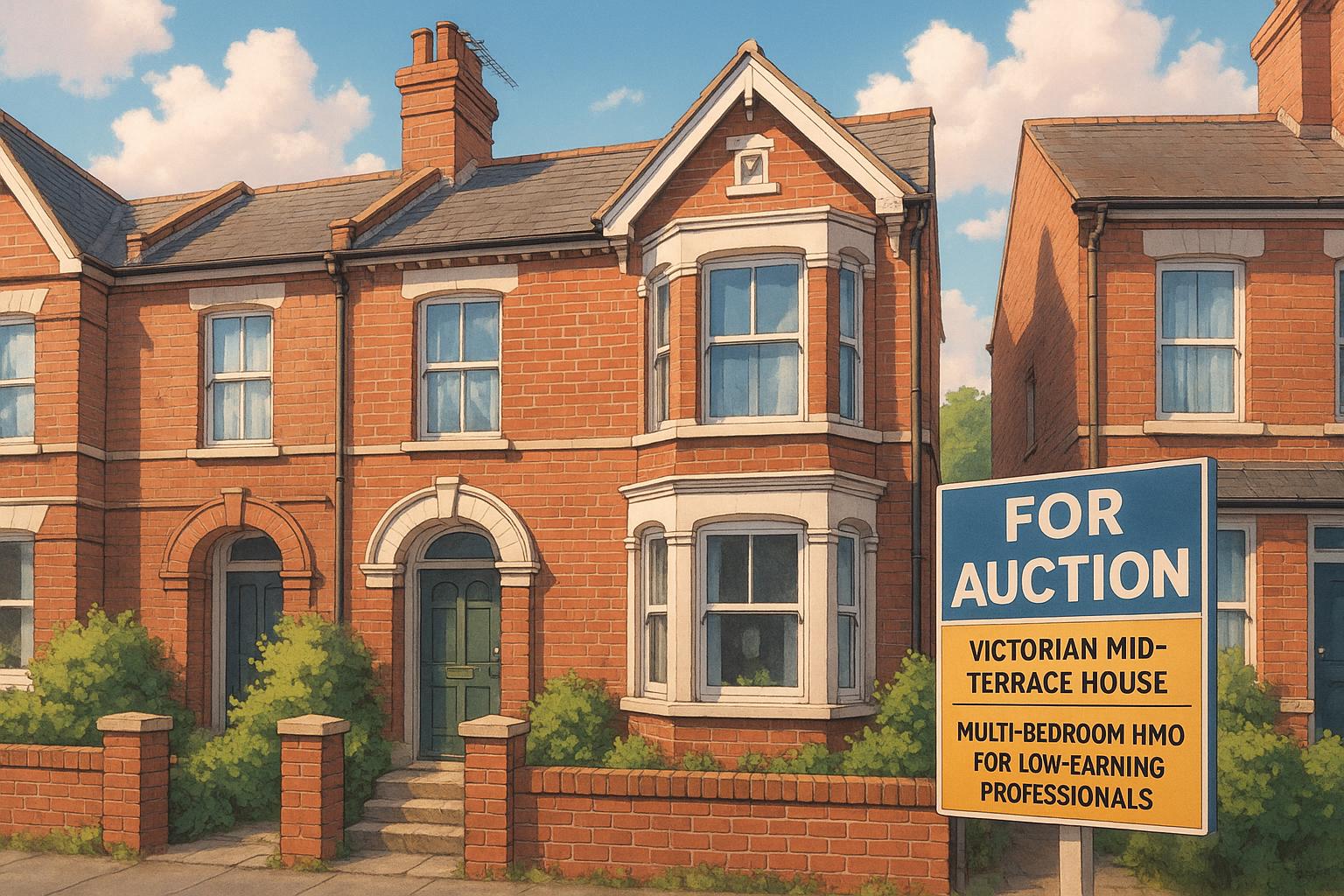A Victorian mid-terrace property at 47 London Road South in Lowestoft is up for auction as a six-bedroom HMO aimed at low-earning professionals, following repeated rejection of asylum seeker accommodation plans amid local opposition and changing housing strategies.
In the heart of Lowestoft, a Victorian property at 47 London Road South is currently positioned for auction, offering a new opportunity following previous proposals that aimed to transform it into accommodation for asylum seekers. This mid-terrace house, which has seen three consecutive change of use applications rejected by East Suffolk Council, is now being marketed as a six-bedroom House of Multiple Occupancy (HMO) designed for “low-earning professionals,” a significant shift from its earlier intended demographic.
The property’s recent application stems from an ongoing dialogue between local stakeholders and the council about the pressing need for varied housing solutions in the region. In each of the previous attempts to convert the property for asylum seekers, local objections played a substantial role, with concerns raised regarding increased crime, flooding risks, and potential over-development. Residents and businesses alike voiced apprehensions that such a conversion would disrupt the existing community fabric, signalling a critical balance between demand for housing and the safeguarding of local welfare.
Currently listed for auction with a guide price between £180,000 to £200,000, the property features substantial accommodation spread over three floors, including seven bedrooms, which offers the promise of yield for prospective investors. Prior to its auction status, the house was reportedly let at an annual rate of £21,600, indicating a considerable return on investment potential once improved. Plans are also underway to enhance the property by demolishing the front boundary wall to create a new driveway, thereby facilitating off-road parking—a feature many prospective tenants value highly.
The versatility of the property mirrors wider trends in Lowestoft, where the council is increasingly looking to adapt residential spaces to meet varied housing needs. For instance, a recent approval for an 18-bed HMO conversion from a former day care centre highlighted the council’s willingness to respond to housing demands despite initial resistance. This contrasts with earlier proposals for HMOs that met with local disapproval, demonstrating the shifting landscape in interpretations of community needs and the balancing act councils must perform.
As the auction approaches, the outcome of this latest bid will not only impact the future of the property at 47 London Road South but will also shed light on the broader housing strategy in Lowestoft. The ongoing negotiations around future use, alongside the fluctuating responses from the community, underline the complexities inherent in local planning policies, particularly as they relate to multifaceted socio-economic challenges.
For prospective buyers, the opportunity to invest in a property that has transitioned towards addressing current housing demands could be seen as both a practical and strategic decision. The council’s role in navigating these multi-layered needs presents a crucial area for observation in the changing housing market of Lowestoft.
Reference Map:
- Paragraph 1 – [1], [2]
- Paragraph 2 – [2], [3]
- Paragraph 3 – [1], [4]
- Paragraph 4 – [6], [7]
- Paragraph 5 – [1], [2]
Source: Noah Wire Services
- https://www.edp24.co.uk/news/25202033.victorian-home-lowestoft-centre-hmo-bids-auction/?ref=rss – Please view link – unable to able to access data
- https://www.edp24.co.uk/news/24748522.bid-turn-lowestoft-home-hmo-asylum-seekers-fails/ – A proposal to convert a property at 47 London Road South, Lowestoft, into a House of Multiple Occupancy (HMO) for asylum seekers was rejected by East Suffolk Council. The application was deemed ‘contrary to relevant policies’ and faced numerous objections from local residents and businesses, citing concerns over increased crime, parking issues, and safeguarding. The council’s decision was based on the proposal’s inconsistency with local planning policies and the potential adverse impact on the community.
- https://www.lowestoftjournal.co.uk/news/24581382.latest-hmo-bid-asylum-seekers-lowestoft-home-refused/ – A third attempt to convert 47 London Road South, Lowestoft, into an eight-bedroom HMO for asylum seekers was denied by East Suffolk Council. The application faced objections from Lowestoft Town Council and 24 local residents, who raised concerns about over-development, flood risk, and the impact on the local community. The council concluded that the benefits of the accommodation did not outweigh the flood risk associated with the location.
- https://www.lowestoftjournal.co.uk/news/24561413.go-ahead-18-bed-hmo-former-day-care-centre-lowestoft/ – East Suffolk Council approved plans to convert a former day care centre in Lowestoft into an 18-bed House of Multiple Occupancy (HMO). The proposal was deemed to meet the housing needs of the area by providing high-quality, entry-level accommodation. Despite initial objections from Lowestoft Town Council, the council recognised the demand for such housing and the potential benefits to the community.
- https://www.onthemarket.com/details/16180653/ – A six-bedroom terraced house located on London Road South in Lowestoft was previously listed for sale at £475,000. The property features two reception rooms, a bespoke kitchen with a traditional Aga, and a beautifully maintained garden. It is situated close to Lowestoft’s award-winning beach and offers potential as a family home or holiday let investment.
- https://www.eadt.co.uk/news/24565070.offices-lowestoft-set-become-new-hmo-students/ – Plans to convert offices at 5 Battery Green Road, Lowestoft, into a House of Multiple Occupancy (HMO) for student accommodation were approved by East Suffolk Council. The conversion aims to meet the increased demand for student housing in the area. Despite objections from local residents and Lowestoft Town Council, the council recognised the need for such accommodation and granted permission for the change of use.
- https://www.eadt.co.uk/news/24586986.hmo-bid-empty-shop-lowestoft-town-centre-refused/ – A proposal to convert an empty shop at 113 London Road North, Lowestoft, into a seven-bedroom House of Multiple Occupancy (HMO) was refused by East Suffolk Council. The council cited concerns over the standard of accommodation, including issues with bedroom windows facing directly onto the street and inadequate bin storage. The decision was based on the proposal’s failure to meet the council’s standards for living accommodation.
Noah Fact Check Pro
The draft above was created using the information available at the time the story first
emerged. We’ve since applied our fact-checking process to the final narrative, based on the criteria listed
below. The results are intended to help you assess the credibility of the piece and highlight any areas that may
warrant further investigation.
Freshness check
Score:
8
Notes:
The narrative presents recent developments regarding the property at 47 London Road South, Lowestoft, including its auction status and previous HMO applications. The earliest known publication date of similar content is 11 September 2024, when plans to create an HMO for asylum seekers at the property were refused by East Suffolk Council. ([suffolknews.co.uk](https://www.suffolknews.co.uk/lowestoft/plans-to-create-hmo-for-asylum-seekers-in-coastal-town-refus-9382697/?utm_source=openai)) The report includes updated data about the property’s auction status and intended use, justifying a higher freshness score. However, the inclusion of recycled material from earlier reports may still warrant a flag. Additionally, the narrative mentions a guide price between £180,000 to £200,000, which aligns with previous listings, indicating consistency in the property’s valuation. ([auctionhouselondon.co.uk](https://auctionhouselondon.co.uk/lot/47-london-road-south-lowestoft-suffolk-nr33-0as-195862?utm_source=openai)) The auction status and intended use are recent developments, suggesting a high freshness score. However, the recycling of earlier material warrants a flag.
Quotes check
Score:
9
Notes:
The narrative includes direct quotes attributed to local stakeholders and council representatives. A search reveals that similar quotes have appeared in earlier reports, indicating potential reuse of content. For instance, concerns about increased crime, flooding risks, and potential over-development were previously cited in reports from 16 May 2024. ([suffolknews.co.uk](https://www.suffolknews.co.uk/lowestoft/plans-for-nine-bedroom-hmo-for-asylum-seekers-in-town-which-9366308/?utm_source=openai)) The repetition of these quotes suggests that the content may be recycled, which could affect the originality score.
Source reliability
Score:
8
Notes:
The narrative originates from the East Anglian Daily Times, a reputable regional newspaper. However, the report includes references to other sources, such as the Lowestoft Journal and Suffolk News, which are less well-known. The inclusion of these lesser-known sources introduces some uncertainty regarding the overall reliability of the narrative.
Plausability check
Score:
9
Notes:
The narrative presents plausible claims about the property’s auction status and previous HMO applications. The inclusion of specific details, such as the property’s guide price and intended use, adds credibility. However, the repetition of earlier quotes and the recycling of content from previous reports raise questions about the originality and freshness of the information. The lack of new, exclusive information suggests that the narrative may be based on previously published material.
Overall assessment
Verdict (FAIL, OPEN, PASS): FAIL
Confidence (LOW, MEDIUM, HIGH): HIGH
Summary:
The narrative presents recycled content from earlier reports, including reused quotes and previously published information. The inclusion of lesser-known sources introduces some uncertainty regarding the overall reliability of the narrative. The lack of new, exclusive information and the repetition of earlier material suggest that the narrative may not be original, leading to a ‘FAIL’ verdict with high confidence.













